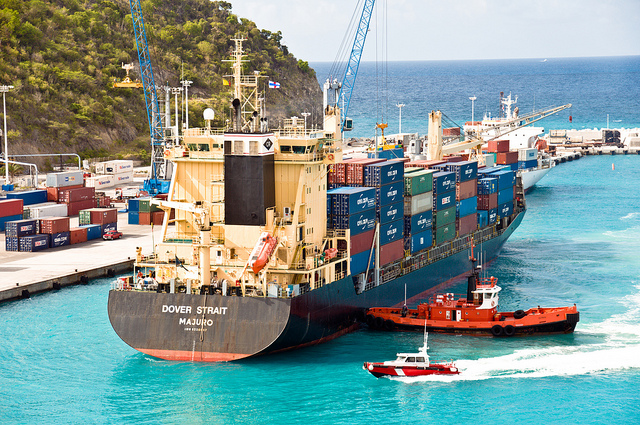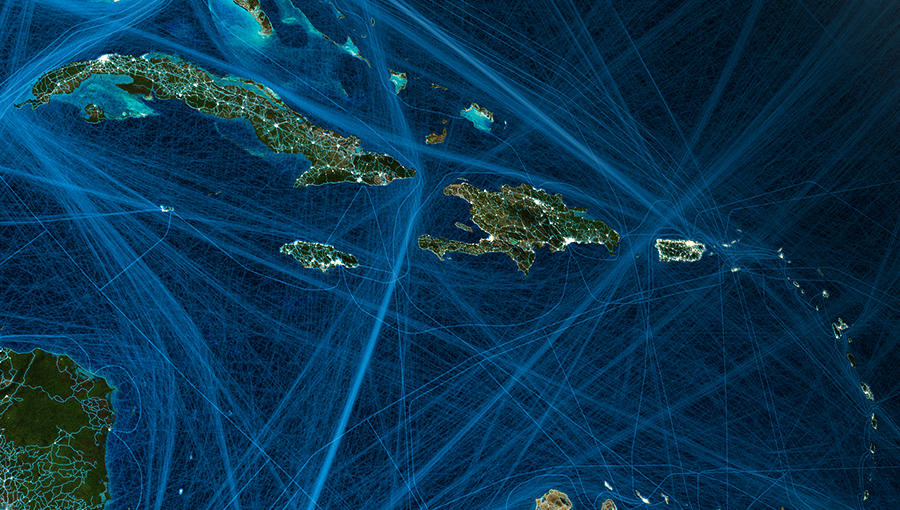Lizard Stowaways Revise Principle of Ecology

When Matthew Helmus was about eight years old and desperate for a pet, he saved up enough money to order a lizard through an ad in the back pages of Mad magazine. The creature arrived in his mailbox a few weeks later — a green anole he dubbed Ari the Anole — and remained his close companion for years. “They make really good pets because they are so robust,” said Helmus, now a research fellow in ecology at VU University in Amsterdam.
This hardy constitution allowed the lizards to creep across the islands of the Caribbean on accidental rafts of logs and flotsam. Nearly 50 years ago, scientists developed a theory to predict how many individual anole species — and how many species more generally — might be found on any given island. Known as island biogeography theory, it dictates that the least isolated islands are the most likely to welcome such visitors. The theory became a seminal tool in ecology, used by researchers to study not only islands, but other semi-isolated environments such as forests surrounded by commercial development.
Helmus has exploited the rugged Anolis lizards to upend island biogeography theory. In a study published today in Nature, Helmus and his co-authors tracked the recent spread of Anolis lizard species across the Caribbean and found that island biogeography will have to be revised. The physical distance between landmasses is no longer important. Shipping lanes are.
The study’s finding signals a major shift in ecology. Until very recently, the field was focused largely on the natural world. Most ecologists viewed humans as an artificial influence that confounded their experiments rather than a driving force shaping the environment and the composition of its residents. But in the last few years, this view has begun to change, as scientists have realized that culture and commerce can’t be isolated or reversed. Human forces must be factored into even the most basic ecological models. The new study is the first to formally update one of the most important mathematical theories in ecology, redefining it to include human factors.
“I don’t think we have fully appreciated how major geographical patterns on earth are going to be changed [by human activity],” said Dolph Schluter, an evolutionary ecologist at the University of British Columbia who was not involved in the research. “It’s astonishing to see such clear evidence that a completely novel factor introduced by humans is changing the basic pattern.”
Many other studies have examined how human activities affect where organisms live. “But no one has taken it a step further, to force us to rethink old theories,” said Nathan Sanders, an evolutionary biologist at the University of Copenhagen who was not involved in the study. The cousins of Ari the Anole — and the man who once had a lizard shipped to him in the mail — are helping researchers rewrite the laws of ecology for the human age.
Island Invaders
In 1969, the biologist E. O. Wilson, then at Harvard University, and Daniel Simberloff, now at the University of Tennessee, Knoxville, published what would become one of the most famous experiments in the field of ecology. They had fumigated a series of small mangrove islands in the Florida Keys, killing off the insects and arachnids that lived there, and then monitored the species’ return.
The experiment was designed to test the theory of island biogeography, which Wilson and his collaborator Robert MacArthur first described in the 1960s. It predicts that the richness of an island’s flora and fauna can be determined by two major factors — the island’s location and size. Isolated islands are less likely to receive migrants from neighboring areas. Large islands offer a diverse range of habitats for species that arrive via emigration as well as for those that arise on the island. Taken together, the two factors predict that large islands located close to shore will be home to many species, while small, distant islands will be home to few.
Just as the theory predicted, the islands closer to the Florida mainland recovered their fauna more quickly. The study has been immortalized in ecology textbooks, and island biogeography theory has become one of the most common approaches to predicting the number of species in a given area.
Yet despite its prominence, the theory has been hard to test at larger scales — on islands hundreds or thousands of square kilometers in size separated by dozens of kilometers. Helmus realized that the spread of exotic (non-native) Anolis lizard species could provide just such a test.
The classic way to assess a model is to manipulate at least one of its variables — in this case, the rates of colonization, speciation and extinction — and see if the changes seen in nature correspond to what the model predicts. Over the past few decades, international trade has increasingly (if unintentionally) altered the colonization rate. Before the appearance of ships, the primary way for Anolis lizards to migrate to a new Caribbean island was to hitchhike on floating logs, which they did only once every 100,000 years or more. But exotic lizards are now colonizing new islands at a rate of about one per year, stowing away in shipments of plants and stores of food. According to island biogeography, the rise in migrants should trigger the greatest increase in lizard species on islands that have the fewest varieties to begin with.

Helmus teamed up with Jonathan Losos, an evolutionary biologist at Harvard who has been studying Anolis lizards since the 1980s, to map this recent spread. Helmus became a lizard detective from his base in Amsterdam, compiling a database of exotic lizard species. He combined existing field data with information he gathered from herpetologists and local lizard enthusiasts. In one case, a priest on Saint Thomas made a special trip to confirm the presence of a specific non-native lizard. “One cool thing about the approach is that it’s based on hard-earned field data collected over many years,” Sanders said. “It’s not just one simple experiment.”
Helmus found that his new data did indeed follow what the model predicted; the islands with the fewest natives gained the most exotics. But the findings show that the amount of economic trade via shipping is now a better predictor of species diversity than geographic location. He concluded that the larger theory of island biogeography only works if researchers replace geographic isolation with a measurement of economic isolation.
Losos, who credits Helmus with coming up with the idea, said he was surprised by the outcome. “To completely wipe out the trends and introduce others, I didn’t see that coming,” he said. “I never would have guessed that economic trade would be such a good predictor.”
Trinidad, for example, sits at the far southern edge of the Caribbean, a location historically isolated from Cuba and the other Greater Antilles — the ancestral source of many of the Anolis species in the Caribbean. It has only one native anole. “But today it is highly connected economically with the nations all across the Caribbean, and it has four exotic anoles, the most exotic anoles of any island in the Caribbean,” Helmus said.
Monitoring Invasive Species
Helmus hopes his findings will aid efforts to monitor invasive species. While some ports screen for exotic organisms, many do not, and checking every cargo container is impractical. The updated model of island biogeography should help regulators predict where potential invasive species are most likely to originate. “If the U.S. trade embargo with Cuba lifts, you can make a strong argument that Cuba should pay attention to where its shipping comes from,” Helmus said. In the next few years, Helmus plans to create an “invasion network,” using genetic analysis of both native and exotic lizards, to map how the animals move among islands. “Then we can compare this invasion network to the shipping network and identify routes and centers of not just past invasions, but possible future invasions as well,” Helmus said.
Cuba, by contrast, has 64 species of lizards, none of them exotic. That’s probably thanks to the U.S. trade embargo, which means Cuba has much less trade than expected for an island of its size. If the embargo were lifted, one to two new species would establish themselves on the island within a few years, according to Helmus.
“Isolation still matters, but we have to consider what it means in a modern human-dominated world,” Losos said.
In other words, even though the basics of island biogeography still hold, the theory needs a rewrite.
Changing the Curve
The earliest iteration of island biogeography theory focused mainly on colonization as a source of new species; Wilson and Simberloff’s famous experiment was designed to test this factor. But later versions began to include speciation, which depends on an island’s size rather than its isolation. On larger islands, which have a greater diversity of ecological niches, the development of new species contributes more to species diversity than the arrival of immigrants. On smaller islands, which can’t support the development of many novel species, new arrivals are the dominant factor.
This relationship can be formalized mathematically. If you plot historical Anolis lizard data on a graph, with island size on the horizontal axis and species richness on the vertical axis, you’ll see a two-part curve. On the left-hand side of the graph — the domain of smaller islands — the slope is shallow. On these smaller islands, isolation, rather than size, is the driving force in determining how many species there are. The right side of the graph, representing larger islands, displays a steeper slope, because speciation here is the dominant factor. Historically, speciation boosted the number of species more quickly than migration did, hence the steeper slope.
Trade has fundamentally altered this relationship. The two-part curve is now roughly linear. That’s because colonization via trade is now the dominant factor in determining an island’s number of species, regardless of the island’s size. The smaller, less diverse islands gained many new species from trade, while the larger islands, already replete with a variety of species, gained fewer, straightening the two slopes into a single line. “An entirely new force is at work in shaping the species-area relationship: trafficking by humans,” Schluter said.
The study also shows that it’s possible to incorporate human factors into ecological models. “There’s a classic view among ecologists that humans are a messy intractable disturbance that they don’t want to include in their models,” said Erle Ellis, an ecologist at the University of Maryland, Baltimore County. “These guys have proven that they can.”
Perhaps most importantly for the field as a whole, the findings reflect how ecology must mature in the Anthropocene epoch, as some scientists now describe the current period of human influence. “We have to think of all those long-held beliefs and theories and the data that underlie them,” Sanders said.
Ellis and others are lobbying to make the anthropocene an official geological epoch, a step that would formalize our impact on ecology even further. “Humans have reshaped the world, and for many species, the factors that affect richness are no longer ones that occurred naturally,” Losos said. “With humans moving things around, we have to rethink what isolation means.”
This article was reprinted on ScientificAmerican.com.



